Pythagoras Theorem
Over 2000 years ago there was an amazing discovery about triangles:
When the triangle has a right angle (90°) ...
... and squares are made on each
of the
three sides, then ... |
|
| ... the biggest square has the exact same area as the other two squares put together! | |
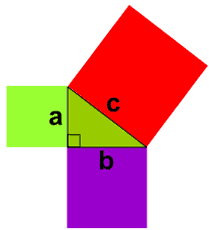
a2 + b2 = c2

- c is the longest side of the triangle
- a and b are the other two sides
Definition
The longest side of the triangle is called the "hypotenuse", so the formal definition is:
In a right angled triangle:
the square of the hypotenuse is equal to
the sum of the squares of the other two sides.
the square of the hypotenuse is equal to
the sum of the squares of the other two sides.
Sure ... ?
Let's see if it really works using an example.Example: A "3,4,5" triangle has a right angle in it.
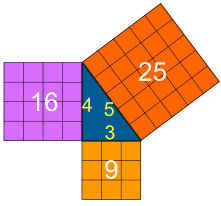 |
Let's check if the areas are the same:
32 + 42 = 52
Calculating this becomes:
9 + 16 = 25
It works ... like Magic! |
Why Is This Useful?
If we know the lengths of two sides of a right angled triangle, we can find the length of the third side. (But remember it only works on right angled triangles!)How Do I Use it?
Write it down as an equation: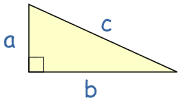 |
a2 + b2 = c2 |
Now you can use algebra to find any missing value, as in the following examples:
Example: Solve this triangle.
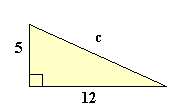 |
a2 + b2 = c2
52 + 122 = c2
25 + 144 = c2
169 = c2
c2 = 169
c = √169
c = 13
|
Example: Solve this triangle.
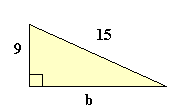 |
a2 + b2 = c2
92 + b2 = 152
81 + b2 = 225
Take 81 from both sides:
b2 = 144
b = √144
b = 12
|
Example: What is the diagonal distance across a square of size 1?
 |
a2 + b2 = c2
12 + 12 = c2
1 + 1 = c2
2 = c2
c2 = 2
c = √2 = 1,4142...
|
Example: Does this triangle have a Right Angle?
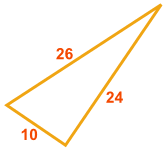 |
Does a2 + b2 = c2 ?
Yes, it does have a Right Angle!
|
Example: Does an 8, 15, 16 triangle have a Right Angle?
Does 82 + 152 = 162 ?
- 82 + 152 = 64 + 225 = 289,
- but 162 = 256
So, NO, it does not have a Right Angle
Example: Does this triangle have a Right Angle?
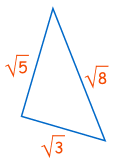 |
Does a2 + b2 = c2 ?
Does (√3)2 + (√5)2 = (√8)2 ?
Does 3 + 5 = 8 ?
Yes, it does!
So this is a right-angled triangle |
And You Can Prove The Theorem Yourself !
Get paper pen and scissors, then using the following animation as a guide:
|
Another, Amazingly Simple, Proof
Here is one of the oldest proofs that the square on the long side has the same area as the other squares.Watch the animation, and pay attention when the triangles start sliding around.
You may want to watch the animation a few times to understand what is happening.
The purple triangle is the important one.
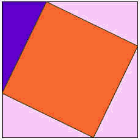 |
becomes | 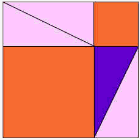 |
We also have a proof by adding up the areas.
What is the Pythagorean Theorem?
You can learn all about the Pythagorean Theorem, but here is a quick summary: |
The Pythagorean Theorem states that, in a right triangle, the square of a (a2) plus the square of b (b2) is equal to the square of c (c2):
a2 + b2 = c2
|
Proof of the Pythagorean Theorem using Algebra
We can show that a2 + b2 = c2 using AlgebraTake a look at this diagram ... it has that "abc" triangle in it (four of them actually):
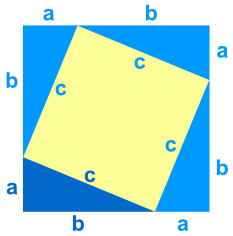
Area of Whole Square
It is a big square, with each side having a length of a+b, so the total area is:
A = (a+b)(a+b)
Area of The Pieces
Now let's add up the areas of all the smaller pieces:| First, the smaller (tilted) square has an area of | A = c2 | |
| And there are four triangles, each one has an area of | A =½ab | |
| So all four of them combined is | A = 4(½ab) = 2ab | |
| So, adding up the tilted square and the 4 triangles gives: | A = c2+2ab |
Both Areas Must Be Equal
The area of the large square is equal to the area of the tilted square and the 4 triangles. This can be written as:
(a+b)(a+b) = c2+2ab
NOW, let us rearrange this to see if we can get the pythagoras theorem:| Start with: | (a+b)(a+b) | = | c2 + 2ab | |
| Expand (a+b)(a+b): | a2 + 2ab + b2 | = | c2 + 2ab | |
| Subtract "2ab" from both sides: | a2 + b2 | = | c2 | |
| DONE! |
Now we can see why the Pythagorean Theorem works ... and it is actually a proof of the Pythagorean Theorem.
This proof came from China over 2000 years ago!
There are many more proofs of the Pythagorean theorem, but this one works nicely.
source: http://www.mathsisfun.com/geometry/pythagorean-theorem-proof.html









0 komentar:
Posting Komentar